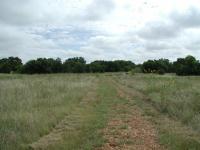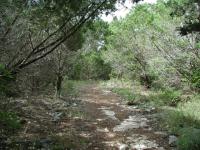Getting there: Take the Slaughter Lane exit from I-35 and head west
on Slaughter Lane. Turn left (south) on Loop 1 (a.k.a. MoPac). Turn left at the next traffic
light at LaCrosse Avenue. The Center is on the right near the end of LaCrosse Ave, past the
Veloway.
The Hike: The Savanna Meadow Trail consists of two named trails at the Lady Bird
Johnson Wildflower Center, the Savanna Meadow Trail and the Woodland Trail. Like the Restoration Research Trail to the south, the Savanna Meadow Trail is open fields providing little cover from the Sun. The Woodland Trail on the other hand provides some shade and a rougher trail surface.
The hike can begin at a couple of points along the northern boundary of the complex of buildings
and display garden beds at the center of the Wildflower Center.

The meadow path is mostly mulched through an open prairie.
The Savanna Meadow Trail portion of this hike slices through grasslands that are briefly
punctuated by small stands of trees. There are a couple of nice views along this trail
overlooking open fields with the main buildings of the Wildflower Center in the background.
A picturesque view probably even more impressive in the spring. The trail surface here
is predominantly mulch and mostly flat. One doesn't really come to the Wildflower Center for
a challenge though.
-small.jpg)
This windmill testifies to the pioneering past of the area.
The Woodland Trail portion of the hike is the roughest to be found here. By hiking standards its very tame, but unlike the Restoration Research Trail (which may be ADA compliant) this trail
consists of a rocky uneven, but not steep, surface. Compared to the rest of the paths the
vegetation here occassionally closes right in on the trail. A snake crossed my path while
hiking through the woodland, though I could not identify the species.
-small.jpg)
Looking back towards the main buildings from the trail.
The Woodland Trail portion of the hike demonstrates what often occurs in the Hillcountry when
fire is taken out of the equation. Dense thickets of Ashe Juniper (Cedar), Oaks, Cedar Elms
and other varieties form and crowd out the sun loving wildflowers. Juniper in particular is very prone to easy burning and is one of the biggest beneficiaries of man's fire suppression.

The trail through the woodland portion of the hike is slightly more rough with rock and hardpack lining the trail. There is some shade though.
Like throughout the Wildflower Center, many species found along the trail are marked by metal
tags either staked into the ground or hanging from a branch. This not only makes for an
enjoyable little hike, but also provides an opportunity to familiarize oneself with plants
native to the area.
The natural landscape is also on display near the junction of the Savanna Meadow and Woodland
trails. A small cave entrance illustrates an entry-point into the complex network of caves and
fissures that criss-cross the landscape in Central Texas. Cave opens like this one often serve
as direct paths for water to enter the aquifers below. Elsewhere openings into the network
serve as the outlet for the water in the form of springs.
The trail forms something of a half loop turning back towards the main buildings. With some
doubling back the hike covered .75 miles. With the heat of the day setting in it was time for
a cool drink at the center's cafe.